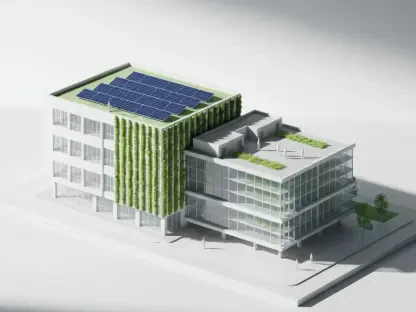In the heart of Birmingham’s prestigious Edgbaston area, a transformative development is unfolding that could redefine luxury living in the Midlands. Spitfire Homes, a renowned premium homebuilder, has acquired a 1.28-acre site on Harrison’s Road, signaling a robust demand for high-specification residences amid a competitive housing market. This move not only highlights the allure of upscale suburban locales but also raises critical questions about affordability, sustainability, and community impact in premium homebuilding. The purpose of this analysis is to dissect the market dynamics driving such projects, evaluate the strategic importance of this specific development, and forecast its implications for the broader housing sector. By examining current trends and future projections, this discussion aims to provide valuable insights for developers, investors, and potential buyers navigating the evolving landscape of luxury real estate.
Deep Dive into Market Trends and Projections
Rising Demand for Premium Suburban Developments
The premium housing market in the Midlands has seen a notable surge, fueled by buyers seeking quality over mass-produced options. Areas like Edgbaston, with their blend of historical charm and modern connectivity, have become prime targets for developers aiming to cater to affluent demographics. Spitfire Homes’ latest acquisition reflects a broader trend where high-net-worth individuals and growing families prioritize lifestyle benefits—such as proximity to top schools and vibrant local amenities—over sheer square footage. Market data indicates that demand for upscale suburban homes has grown steadily over the past few years, with projections suggesting continued expansion through at least 2027 as urban sprawl pushes buyers toward well-connected yet tranquil neighborhoods.
This trend is not without challenges, as escalating land costs in prestigious zip codes often translate to higher property prices, potentially narrowing the buyer pool. However, the inclusion of initiatives like the First Homes Scheme in projects such as this one demonstrates an industry shift toward balancing exclusivity with accessibility. Developers are increasingly tasked with meeting diverse needs, ensuring that premium does not equate to unattainable. As a result, the market is witnessing a nuanced evolution, where strategic site selection and innovative pricing models play pivotal roles in sustaining growth.
Architectural Innovation and Buyer Expectations
Another defining feature of today’s premium housing market is the emphasis on design excellence and customization. Spitfire Homes’ Edgbaston project, featuring a mix of one- and two-bedroom apartments alongside four-bedroom semi-detached townhouses, showcases how developers are tailoring offerings to varied buyer profiles, from young professionals to established families. The focus on contemporary aesthetics—clean lines, high-end finishes, and meticulous detailing—aligns with consumer expectations for homes that are both functional and visually striking. Industry analysis suggests that such design-led approaches are becoming a key differentiator in a crowded market, with buyers willing to pay a premium for unique, well-crafted spaces.
Sustainability also emerges as a critical factor shaping buyer preferences and developer strategies. Energy-efficient designs and eco-friendly materials are no longer optional but expected in high-end developments. This shift is partly driven by regulatory pressures and partly by a growing consumer awareness of environmental impact. Looking ahead, the integration of smart home technologies and modular construction techniques could further redefine luxury, offering personalized and adaptable living solutions. For developers, staying ahead of these innovations will be essential to maintaining a competitive edge in an increasingly discerning market.
Community and Economic Impacts in Focus
Beyond individual homes, the broader economic and social implications of premium developments are significant. Spitfire Homes’ commitment of over £100,000 to local infrastructure in Edgbaston underscores a growing trend among developers to invest in community enhancement as part of their projects. Such contributions can improve public spaces, bolster transport links, or support educational facilities, creating a ripple effect that benefits both new residents and the existing population. Market observers note that this approach not only mitigates potential community resistance but also enhances the long-term value of the development by fostering a cohesive, well-supported neighborhood.
Economically, projects in high-value areas like Edgbaston stimulate local economies through job creation during construction and increased foot traffic for nearby businesses post-completion. However, there are risks to consider, including potential delays in infrastructure improvements or inflationary pressures on property prices due to heightened demand. Analysis of similar developments suggests that while immediate economic boosts are common, sustained impact depends on careful planning and stakeholder collaboration. As the market evolves, the ability to balance profit motives with social responsibility will likely become a benchmark for success in premium homebuilding.
Location as a Market Driver
The strategic importance of location cannot be overstated in the premium housing sector, and Edgbaston exemplifies this principle. Positioned within walking distance of Edgbaston Village and Harborne High Street, the Harrison’s Road site offers residents access to a vibrant mix of independent eateries, boutique shops, and scenic parks. Excellent transport links to Birmingham’s city center further enhance its appeal, catering to commuters seeking a balance of suburban calm and urban convenience. Market trends indicate that such locations are increasingly coveted, with proximity to amenities often outweighing sheer property size in buyer decision-making processes.
Yet, this desirability also poses challenges, as rising demand can drive up costs, potentially pricing out segments of the market. The incorporation of schemes to support first-time buyers in this development addresses some of these concerns, reflecting an industry push toward inclusivity. Comparative analysis with other premium suburban markets reveals that locations blending connectivity and lifestyle benefits consistently outperform isolated or less accessible areas in terms of property appreciation and buyer interest. This dynamic suggests that future growth in the sector will likely concentrate on similarly well-positioned locales, provided developers can navigate the associated cost pressures.
Reflecting on Market Insights and Strategic Pathways
Looking back, the analysis of Spitfire Homes’ Edgbaston development illuminated critical trends that shape the premium housing market, from the surge in demand for upscale suburban residences to the growing emphasis on design innovation and sustainability. The strategic selection of a prime location, paired with community-focused initiatives, highlighted how developers balance luxury with broader social impact. Economically, the project underscored the potential for such ventures to stimulate local growth, though not without risks tied to pricing and infrastructure delivery.
Moving forward, stakeholders in the housing sector are encouraged to prioritize adaptability, integrating emerging technologies and sustainable practices to meet evolving buyer expectations. Developers could consider replicating community investment models to build goodwill and enhance project viability in competitive markets. For investors, the enduring appeal of well-connected, prestigious areas like Edgbaston suggests strong long-term value, warranting careful evaluation of similar opportunities. Ultimately, the path ahead points toward a collaborative approach, where innovation, accessibility, and local enhancement converge to redefine the future of premium homebuilding.









